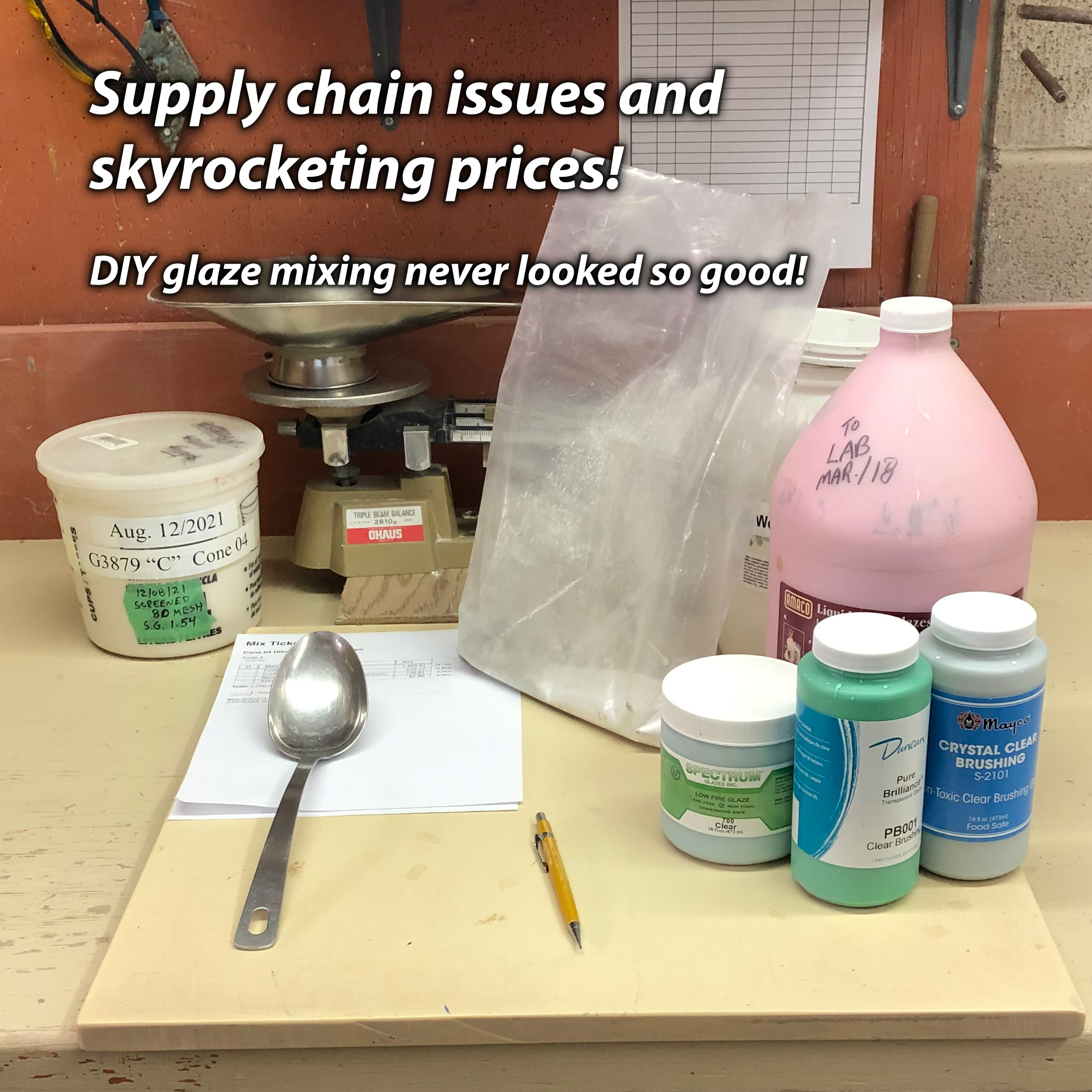| Monthly Tech-Tip | No tracking! No ads! | |
Global supply chain issues? Learn to mix and adjust your own bodies, glazes
Material prices are sky rocketing. And, the more complex your supplier's supply chain the more likely they won't be able to deliver. How can you adapt to coming disruption, even turn it into a benefit? Learn to create base recipes for your glazes and even clay bodies. Learn now how to substitute frits and other materials in glazes (get the chemistry of frits you use now so you are ready). Even better: Learn to see your glaze as an oxide formula. Then calculate formula-to-batch to use whatever materials you can get. Learn how to adjust glazes for thermal expansion, temperature, surface, color, etc. And your clay bodies? Develop an organized physical testing regimen now to accumulate data on their properties, learn to understand how each material in the recipe contributes to those properties. Armed with that data you will be able to adjust recipes to adapt to changing supplies.
Related Pictures
Make your own vibrating sieve
And process your own super-fine clays

This picture has its own page with more detail, click here to see it.
Being more independent is now cool again. Actually, it is being forced upon us by necessity because of supply chain issues and skyrocketing prices of convenience glazes, bodies, engobes, etc. Independence involves using sieves. True, it is no problem for a potter or lab tech to manually coax a glaze slurry through a small 80# sieve. But real independence is about sieving in volume - clay bodies made from your own native clays. And doing it at up to 325 mesh. That requires a vibrating sieve. This one cost us less than $100 to make. Of course, a Tyler sieve (or similar) is needed, these can be purchased on Ebay or Amazon. And a vibration motor, some metal and hardware and a friend with metal fabrication tools. This demonstrates the utility of a vibrating sieve, the idea can be scaled to any size you need. As an example, oil well drilling sites here have to remove particulates from huge volumes of drilling mud and they do it on giant multi-level units.
When Supply Chains Broke, Prices Soared.
We haven’t forgotten. Time for DIY!

This picture has its own page with more detail, click here to see it.
Material prices were sky rocketing (and still are). Prepared glaze manufacturers have complex international supply chains. Now might be the time to start learning how to weigh out the ingredients to make your own. Armed with good base glazes that fit your clay body (without crazing or shivering) you will be more resilient to supply issues. Add stains, opacifiers and variegators to the bases to make anything you want. That being said, ingredients in those recipes may become unavailable! That underscores a need to go to the next step and "understand" glaze ingredients. And even improve and adjust recipes. It is not rocket science, it is just work accompanied by organized record-keeping and good labeling.
Videos
| Media |
Substitute Ferro Frit 3134 For Another Frit
I use my Insight-live account to do the glaze chemistry to replace Ferro frit 3134 with combinations of three other common Ferro frits. We will see the challenges of doing this in three different types of recipes. |
Links
| Articles |
Where do I start in understanding glazes?
Break your addiction to online recipes that don't work or bottled expensive glazes that you could DIY. Learn why glazes fire as they do. Why each material is used. How to create perfect dipping and brushing properties. Even some chemistry. |
| Articles |
Glaze Recipes: Formulate and Make Your Own Instead
The only way you will ever get the glaze you really need is to formulate your own. The longer you stay on the glaze recipe treadmill the more time you waste. |
| Articles |
Formulating a Porcelain
The principles behind formulating a porcelain are quite simple. You just need to know the purpose of each material, a starting recipe and a testing regimen. |
| Articles |
Ceramic Tile Clay Body Formulation
An overview of the technical challenges a technician in the tile industry faces in making good tiles from the least expensive materials and process possible. |
| URLs |
https://digitalfire.com/4sight/material/index.html
Digitalfire Reference Database This is the traditional ceramics reference website that couples with your account at insight-live.com. |
Got a Question?
Buy me a coffee and we can talk

https://digitalfire.com, All Rights Reserved
Privacy Policy

